"About 1130, Louis VI moved his official residence to
Paris, spurring much commercial activity and a great
building boom. Paris soon became the leading city of
France, indeed of all northern Europe, making a new
cathedral a necessity. Notre-Dame of Paris occupies a
picturesque site on an island in the Seine River called the
Ile -de-la-Cite. The Gothic church ... has a
complicated building history. The choir and transept
were completed by 1182; the nave by ca. 1225; and the facade
not until ca. 1250 - 1260."
- Gardner's
Art Through The Ages,
11th edition, Vol. I, pp. 495
Notre Dame de
Paris Facade
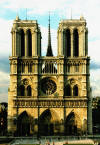
Notre Dame de Paris Back view
"To hold the much
thinner - and taller - walls of Notre-Dame in place, the
unknown architect introduced flying buttresses, exterior
arches that ... counter the outward thrust of the nave
vaults. Flying buttresses seem to have been employed
as early as 1150 in a few smaller churches, but at
Notre-Dame in Paris they circle a great urban cathedral. ...
The precisely positioned flying buttresses and rib vaults
with pointed arches was the ideal solution to the problem of
constructing towering naves with huge windows filled with
stained glass. The flying buttresses, like slender
extended fingers holding up the walls, are also important
elements contributing to the distinctive "look" of Gothic
cathedrals."
- Gardner's
Art Through The Ages,
11th edition, Vol. I, pp. 496

"In contrast to
monastic churches, which were usually small and completed
fairly quickly, the building histories of urban cathedrals
often extended over decades and sometimes over centuries.
The financing depended largely on collections and public
contributions (not always voluntary), and a lack of funds
often interrupted building programs. Unforeseen
events, such as wars famines, or plagues, or friction
between the town and the cathedral authorities would stop
construction, which then might not resume for years. ... The
rebuilding of Chartres cathedral after 1194 took a
relatively short 27 years, but at one point the townspeople
revolted against the prospect of a heavier tax burden.
They stormed the bishop's residence and drove him into exile
for four years."
- Gardner's
Art Through The Ages,
11th edition, Vol. I, pp. 497
Chartres at Night

"Despite the vastly
increased size of the clerestory windows, the Chartres nave
is relatively dark. The explanation for this seeming
contradiction is that light-muffling colored glass fills the
windows. These windows were not meant to illuminate
the interior with bright sunlight, but to transform natural
light into Suger's mystical lux nova [new light].
Chartres retains almost the full compliment of its original
stained glass, which , although it has a dimming effect,
transforms the interior's character in dramatic fashion."
- Gardner's
Art Through The Ages,
11th edition, Vol. I, pp. 499
Stained Glass Window (Nativity) in Chartres
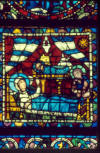
"In the German
Rhineland, then still ruled by the successors of the
Carolingian and Ottonian emperors, work began in 1176 on a
new cathedral for Strasbourg, today a French city. The
apse, choir, and transepts were in place around 1240."
- Gardner's
Art Through The Ages,
11th edition, Vol. I, p. 524
Strasbourg
Cathedral Aerial View

Strasbourg Cathedral: View
from the Street
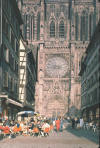 and a view at night:
and a view at night:
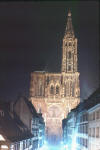
"In Gothic France, as
already noted, art became increasingly humanized and
natural. In Gothic Germany artists carried this
humanizing trend even further by emphasizing passionate
drama. Heightened emotionalism (or expressionism)
proved an important ingredient of German art in succeeding
centuries and even in the modern era."
- Gardner's
Art Through The Ages,
11th edition, Vol. I, pp. 524 - 525
Strasbourg Cathedral
Architectural Ornamentation
(Doorway Tympanum)
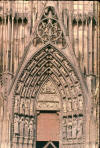
Strasbourg Cathedral Interior
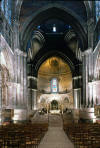
"Stained glass is
almost synonymous with Gothic architecture. No other
age produced windows of such rich color and beauty.
The art of making colored glass is, however, very old.
Egyptian artists excelled at fashioning colorful glass
vessels and other objects for both home and tomb.
Archaeologists also have uncovered thousands of
colored-glass artifacts at hundreds of sites throughout the
classical world."
- Gardner's
Art Through The Ages,
11th edition, Vol. I, p. 500
Strasbourg Cathedral Stained-Glass Windows
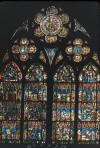
"But if the technology
of manufacturing colored glass was ancient, how artists used
stained-glass in the Gothic period was new.
Stained-glass windows were not just installed to introduce
color and religious iconography into church interiors.
That could have been - and was much earlier - done with both
mural paintings and mosaics, often with magnificent effect.
But stained-glass windows differ from those earlier
techniques in one all-important respect. They do not
conceal walls; they replace them. And they transmit,
rather than reflect light, filtering and transforming the
natural light as it enters the building. ... Hugh of
Saint-Victor, a prominent Paris theologian who died while
Suger's Saint-Denis was under construction, also commented
on the special mystical quality of stained-glass windows.
"Stained-glass windows," he wrote, "are the Holy Scriptures
. . . and since their brilliance lets the splendor of the
True Light pass into the church, they enlighten those
inside." "
- Gardner's
Art Through The Ages,
11th edition, Vol. I, p. 500
Strasbourg Cathedral Roses Window **
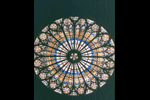
Illuminated Manuscripts -
This manuscript, from the
Getty Collection
in Los Angeles, was made in Italy in the 13th century.
It is painted on parchment using tempera paints. It
follows some of the styles of
Byzantine art,
but is clearly from the West and Roman Catholic in its use
of Latin texts. The dramatically illustrated letter,
shaped like a heavenly throne upon which Christ is seated,
is the letter "A" from the word "Aspitiens" (English: Look
or Behold). The bulk of the page itself is occupied with the
musical notation which indicates the relative pitches and
relative durations used to sing this text.
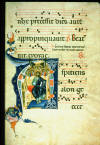
|